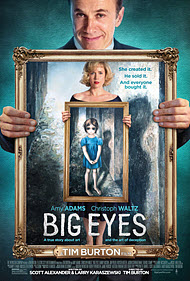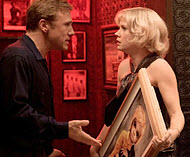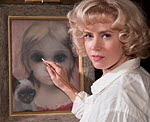Big Eyes
 for thematic elements and brief strong language.
for thematic elements and brief strong language.
Reviewed by: Nicole Granath
CONTRIBUTOR
| Moral Rating: | Offensive |
| Moviemaking Quality: |
|
| Primary Audience: | Adults Teens |
| Genre: | Biography Drama |
| Length: | 1 hr. 45 min. |
| Year of Release: | 2014 |
| USA Release: |
December 25, 2014 (wide—1,307 theaters) January 2, 2015 (wide—1,408 theaters) DVD: April 14, 2015 |






lying and deception versus truth
What about feminism and women’s lib?
Margaret D. H. Keane (Wikipedia)
Walter Stanley Keane (Wikipedia)
| Featuring |
|---|
|
Amy Adams … Margaret Keane Christoph Waltz … Walter Keane Krysten Ritter … DeeAnn Jason Schwartzman … Ruben Terence Stamp … John Canaday Danny Huston … Dick Nolan See all » |
| Director |
|
Tim Burton |
| Producer |
|
Silverwood Films Electric City Entertainment Tim Burton Productions The Weinstein Company |
| Distributor |
“She created it. He sold it. And everyone bought it.”
A newly single mom, Margaret (Amy Adams) with a daughter to support, meets a charming, kind, and generous man named Walter (Christoph Waltz), who seems to be the prince of her dreams. Both looking for a new start, and both burgeoning artists, they quickly marry, going on a romantic honeymoon together in beautiful Hawaii.
However, upon returning to the mainland, Margaret discovers that her new husband’s charm is beginning to wear off. Although their shared passion for painting initially brought them together, it soon becomes clear that Walter Keane’s interest in art has more to do with business than pleasure. At first, Walter appears to be helping Margaret get her artwork noticed, while also selling some paintings of his own. But when Margaret’s “Big Eye” paintings become more popular with the public, Walter begins taking credit for his wife’s work. Walter claims that no one wants to buy “lady art,” and that without his wit and charm to close the deal, Margaret’s paintings would never sell.
Feeling coerced and without recourse, Margaret goes along with the lie, to her own emotional detriment. The lie also damages her relationship with her daughter, as she locks herself in her art studio and paints for hours on end, day after day. Sworn to secrecy by her husband, not even Margaret’s daughter is allowed to know the truth about who the real artist is. As the family acquires wealth and fame through Margaret’s increasingly popular paintings, Walter’s demands on Margaret only increase. Can the new car, bigger house, and celebrity friends quiet the fierce and ever-growing desperation Margaret feels inside?
Positive Elements
Margaret and her daughter share a close relationship throughout the film, although they become somewhat estranged for a time, due to Margaret’s secrecy regarding her paintings. When Margaret lies to her daughter, she feels convicted and goes to a priest to confess her sin. Margaret is not really seeking fame or riches with her artwork. She just wants to do what she loves, which is to paint. Also, Margaret doesn’t allow herself or her daughter to stay in an abusive situation, once it becomes clear that her relationship with Walter has escalated to that point.
The film does a good job of portraying a woman who starts off as naive and fearful, and how she eventually overcomes her feelings of helplessness and shame to do what’s right. There is no nudity in the film and little, if any, sexual content, and there are very few obscenities.
Negative Elements
One character is seen “flipping off” another character, and some curse words, including the f-word, are exchanged. In one scene, two characters get into a physical fight in a bar/club. In the beginning of the film, Margaret and her daughter are shown packing up their belongings and leaving Margaret’s first husband. An explanation is never really given, except that the husband was “smothering,” which doesn’t seem like a very good reason, in and of itself, for ending a marriage. Margaret jumps into her next marriage rather suddenly, which is probably not a very prudent idea. However, it is portrayed as a red flag in the movie.
Margaret allows her husband to lie to the public about being the artist behind her “Big Eye” paintings, and she goes along with his lie, as well. Although the truth is eventually brought to light, for a long time Margaret is too weak and fearful to be honest with the public, or her own daughter. The lie is portrayed as being wrong, though, and the fact that the truth will eventually come out is a strong theme in this movie.
The movie portrays Margaret’s redemption as coming through her conversion to Jehovah’s Witnesses, when two members of the Watchtower Society visit her home and share their beliefs with her. While many of the Scriptures shared in the movie are from our actual Bible, it is important to realize that Jehovah’s Witnesses are a cult. As Paul says in the New Testament,
“But even if we, or an angel from heaven, should preach to you a Gospel contrary to what we have preached to you, he is to be accursed!”
We are not to accept other versions of the Gospel, which do not align with God’s Holy Word. Any other version of the Gospel that contradicts the Bible is actually a lie from Satan, and not the true Gospel at all.
Tips on Witnessing to Jehovah’s Witnesses (in our EffectiveEvangelism section
Why is Creation the best place to start in witnessing to Jehovah’s Witnesses?
How do Jehovah’s Witnesses’ teachings about Christ compare with Scriptures?
Violence: Moderate / Profanity: Heavy—“My G*d” (4), “hell” (6), “G*d-d*mn,” “For Chr*st’s sakes,” “For G*d’s sakes,” “Jesus,” “Christ,” “Good G*d,” and “Oh God,” “d*mn,” “f*** you,” s-words (4), SOB / Sex/Nudity: Moderate—passionate kiss, swim suits, cleavage, bare breasts in a painting, a sexual remark
See list of Relevant Issues—questions-and-answers.


The fact that, toward the end of the movie, the Jehovah’s Witnesses came to help her in seeing that it was wrong to lie was no reason to put down these people, in a cult, trying to help. The movie showed that Jehovah’s Witnesses are nice people. They are, for the most part, nice people. It is true that we Christians know that the nice people in the Jehovah’s Witnesses are in a cult that is not of God, and, yes, they need Jesus. Yet, still, they are moral people, like the people in the cult of the Mormon Church; they are in a cult, yet still a moral people that try to do good.
Only Jesus will get us to Heaven, not our morals, on a human level. It’s almost a Hollywood ritual to make moral people, trying to do good, look like stupid imbeciles. At least, in this movie, they made the Jehovah’s Witnesses nice folk trying to help.
The husband was a real nut case taking credit for her paintings for years (evil heart). It was nice to see justice done at the end of the movie.
Moral rating: Offensive / Moviemaking quality: 3
PLEASE share your observations and insights to be posted here.

How this all comes about is clearly presented by a decent screenplay. Walter is the central figure in the story, as he charmingly and convincingly pressures his wife into letting him present her work to the world as his original paintings.
Waltz nails the role, so this is actually his tour de force movie. There is a dimension of sadness to the story, as it appears that Walter is truly, terribly in love with the notion of being a Paris-trained artist, and Margaret understands that his claiming her art as his own achievement is a clever and successful marketing strategy, although it deprives her of her self-esteem and dignity.
They become rich, but they don’t live happily every after.
My Ratings: Moral rating: Average / Moviemaking quality: 4